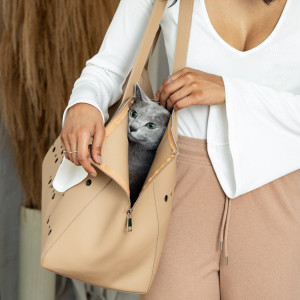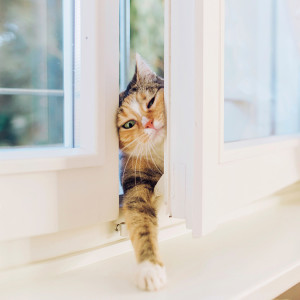How to Move House With Your Cat
Who is more stressed, you or your feline?
They say moving house is one of the most stressful life events you can go through – in fact 57% of Britsopens in new tab ranked it the most stressful, more so than having a child, starting a new job or going through a divorce. And do you know who else in your life gets stressed pretty easily? Your cat. Cats are extremely sensitiveopens in new tab to changes in their environment and schedule (if you’ve ever fed your cat five minutes late and seen that look of utter contempt, you’ll know what I mean), so uprooting them out of the familiar and into a new space can be a very dramatic change for them. Which is why when I moved house last month, I knew I’d have to take my cat Kobe’s emotional well-being into consideration and make the transition into our new home as smooth and stress-free as possible.
Step one: packing
While cats do have a particular obsession with boxes (thank you Amazon for providing two-in-one gifts for both me and Kobe every time I order something), starting to pack up all the items in your cat’s territory can be both confusing and stressful for them. “Including your cat in every stage of moving can help them adjust to the change more easily,” explains trainee animal behaviourist Lottie Phillips, who suggests letting your cat sniff the boxes and watch you pack things so they start to understand that something is happening. Kobe kept a keen eye on all the proceedings but ultimately wanted to stay out of the way and sought out hiding spaces under furniture that he’d never usually use.
“Make sure they have a safe spot to escape to if things get too overwhelming and remember that even the sound of you using packing tape can be disturbing to them,” says Lottie. It’s also important to ensure all your cat’s personal items, such as their food bowls, litter box, toys and scratching posts are left alone so that they have some stability in their territory. Lottie cautions that no matter how stressed you feel and how much you have on your plate to prepare for the move, making sure your cat’s normal schedule remains consistent is key to helping reduce their stress levels.
Step two: relocate your cat
Although this isn’t a necessity, I decided that I needed to get Kobe out of the way during the weekend of the actual move. The thought of all my friends marching in and out of the house carrying boxes and him having to witness this chaos and then getting dropped into a new environment full of all the aforementioned boxes (honestly, who knew I had so much stuff) seemed way too overwhelming for him. And perhaps slightly selfishly, the thought of also having to corral him into the carrier in the midst of all this was a challenge I wasn’t prepared to endure.
“If you are taking your cat out of the equation, get their carrier out a few days before so they have some time to get reacquainted with it,” says Lottie. And if you don’t relocate your cat during moving day? “Make sure they’re confined in an empty room with no chance of escape while the movers are there and put your cat in the carrier as the very last thing you do,” she says.
So a few days before the moving date, Kobe went to stay with a trusted feline-loving friend for the weekend. This was a bit of a trade-off though, as I knew this staycation would be stressful in itself for Kobe: he’d have to get in the carrier, go on a short car journey and be transplanted somewhere new. Lottie recommends giving your cat all their favourite things from home to help them settle into a new place if you have to leave them for a few days while you move.
Although my journey was short and we took a pet Uber, whenever you’re taking your cat on a road trip, make sure they’ve had the opportunity to go to the toilet and that they’ve abstained from food for a little while beforehand, as Lottie says stress can bring on accidents. If you’re travelling by car, you should place the cat carrier on the back seat and, if possible, strap it in with the seatbelt. But no matter how much they meow, do not let your cat out the carrier in the car.
Step three: prepare your new place
Once the move was complete (the less said about that day, the better), Lottie says if you can make the new place as non-chaotic as possible, that will help your cat’s stress levels when you bring them home. “Your cat is going to be freaked out no matter what,” explains Lottie, but there are ways to minimise this. Cue a frantic few days of unpacking and setting up all Kobe’s areas; although the litter box and his food bowls were with him at my friends’, I made sure I knew where these were going and also ensured there were inviting hiding spots around the house.
“Now is not the time to introduce any new belongings for your cat,” says Lottie. “As tempting as it is to buy new bowls that match your interior or upgrade the litter box, you want to keep their stuff the same.” She also recommends plugging in a Feliway diffuseropens in new tab, which emits calming pheromones into the environment.
Step four: bring your cat home
After a few days, I went to collect Kobe and bring him home. He was not happy. Not only had he had to go in the carrier twice, go on two car journeys and spend the weekend without me, I was now bringing him back somewhere unfamiliar. “Cats’ first instinct in a new and scary environment is to hide,” says Lottie. Which is exactly what he did. He immediately found a hiding spot in the back of the wardrobe and was displaying some signs of fear, which can include the following:
freezing in place or making themselves small by crouching low to the ground and lowering their head
running away
hiding
arching their back and puffing up their fur
wide eyes with big pupils that look like ovals or circles
tucking their tail under them or swishing the tip quickly side to side
moving their ears quickly (as they try to listen) or flattening their ears close to their head
hissing or spitting
scratching or biting
peeing or pooing outside their litter box
Lottie says it’s all about patience and reassurance, so I sat down on the floor next to the wardrobe with a bag of Dreamies and spoke to him softly to let him know I was there and it was going to be OK.
“If you have the space, you should dedicate one room where they can stay,” says Lottie. The room should contain everything your cat would need during this time, such as food, bedding, toys and a litter box. “Cats use their senses to figure out whether something is safe,” says Lottie. Placing their favourite blanket or a piece of your clothing with them can help them feel comfortable (maybe that’s why he chose the wardrobe). They will feel safe within a confined space and it will give them the opportunity to slowly familiarise themselves with the new sounds and smells. It also gives them a spot of their own to use later as a refuge.
After a few hours, I left Kobe to it and he eventually did come out and start exploring the new place in small bursts, making sure to dart back to the hiding spot when it got too much. “Don’t try and force your cat to come out, let them do it in their own time,” says Lottie. “And while we might appreciate hugs when we’re scared, picking your cat up can make them feel unsafe as you’re taking away their freedom of movement and ability to flee if they want to. So avoid picking them up and giving them a tour of your new house in your arms – let them do everything on their own time.”
Things to watch out for
After his initial freakout, Kobe was quick to adjust. But Lottie cautions that stress can cause a number of health issues in cats and says it’s important to keep a close eye on your cat’s physical health and behaviour. If your cat is displaying any of these signs of stress, Lottie says calling your vet should be your first port of call if they don’t resolve after a few days.
large bald patches or sores on the coat caused by over grooming
symptoms get worse in cats with chronic health conditions or recovery from illness is slow (stress can affect a cat’s immune system and ability to fight disease)
eating non-food items such as plastic or wool (this is called ‘pica’)
poor appetite or eating less than normal
looking lethargic and sleeping more than usual
excessive eating and/or drinking
sudden weight loss or weight gain
a poor coat condition
not going to the toilet as often as usual (faeces and/or urine)
frequent squatting, painful urination with blood in it (cystitis)
Lottie reiterates the importance of keeping their previous schedule consistent and feeding them at the same times you always have. It’s also very important that if your cat is an outdoor cat, that you keep them safely confined inside for a minimum of two weeks (that means making sure they don’t dash out the door or escape through windows, too). This will give them enough time to learn that this is now their home and their sanctuary where all their needs are met. “Letting a cat out too soon can risk them getting lost outside as they try to find their way back to their old territory, even if it’s a very long way away,” says Lottie.
And finally, although you may have hundreds of things to do and sort every day, ensuring you make time to play with your cat and give them comfort and reassurance is the quickest way to a happy life together in your new home.












